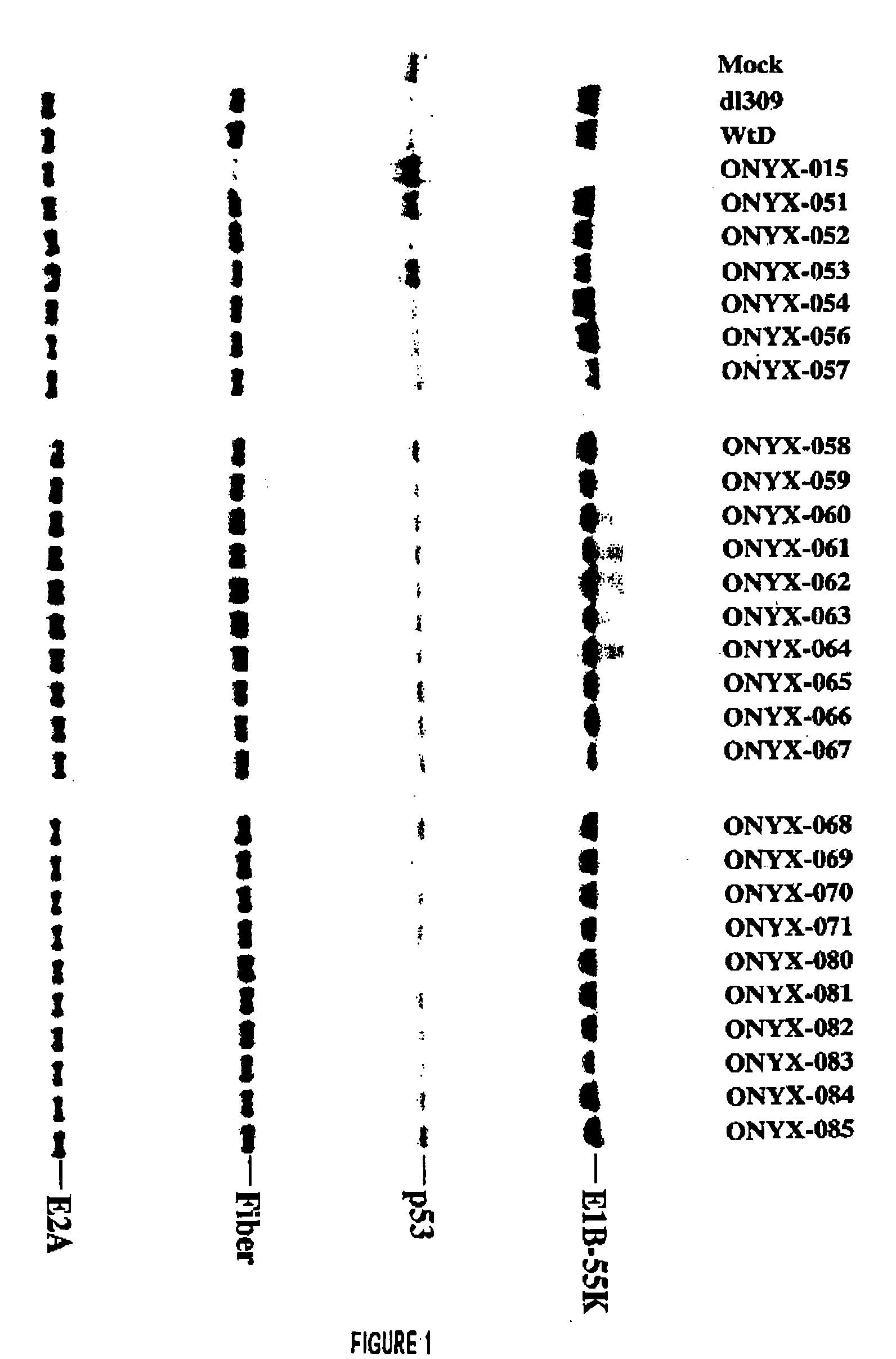Adenovirus E1B-55K single amino acid mutants and methods of use
- Summary
- Abstract
- Description
- Claims
- Application Information
AI Technical Summary
Problems solved by technology
Method used
Image
Examples
example 1
Construction of E1B-55K Mutant Viruses
[0090] All E1B-55K mutants were generated using Stratagene's QuikChange™ Site-Directed Mutagenesis Kit following the manufacturer's recommended protocol. For each mutation, a forward primer and a reverse primer were used. The mutations and their respective primers are summarized in Table 2, below. Briefly, 20 ng of pXC-1 was used as the template and the cycling parameters were as follows: 1 cycle of 95° C. for 30 seconds, 16 cycles of 95° C. for 30 seconds, 55° C. for 1 minute and 68° C. for 20 minutes. The plasmid pXC-1 was obtained from Microbix Biosystems, Inc., located at 341 Bering Avenue, Toronto, Ontario Canada and contains the entire E1 region, E1A and E1B. The parental DNA was digested by adding 10 U of Dpn I to each sample and incubating for 1 h at 37° C. Final products were transformed into XL-1 cells (Stratagene Corp.), and confirmed by DNA sequencing.
[0091] Viruses were constructed by co-transfecting pJM17 with plasmids containing...
example 2
Binding of E1B-55K Mutants with p53 and E4orf6
[0092] The twenty six mutant adenovirues produced as described in Example 1 were initially screened to determine their effect on the steady-state levels of p53 in A549 cells. The rationale for conducting this experiment is that E1B-55K collaborates with E4orf6 to target p53 for active degradation. Thus, to identify E1B-55K mutants that lack this activity, we examined the steady-state level of p53 in infected A549 cells by Western blotting analysis (FIG. 1). Similar experiments were done with Onyx 015, wild type D (WtD) adenovirus, and dl309.
[0093] Western blotting analysis was carried out as follows. A549 cells were infected with various viruses at an MOI of 10. At 24 h post-infection, the cells were lysed in SDS gel loading buffer (100 mM Tris-Cl [pH 6.8], 5 mM EDTA, 1% SDS, 5% beta-mercaptoethanol). Proteins were fractionated by electrophoresis on Bio-Rad pre-cast protein gels. After electrophoresis, the proteins were electrophoretic...
example 3
Effects of E1B-55K Mutations on Late Viral Functions
[0101] Cold Sensitivity. It is known that the replication of adenoviruses that have partial or complete deletion of the E1B-55K gene is temperature dependent (Leppard, K. N., J. Gen. Virol., 1993, vol. 74: p. 575-582; Goodrum, F. D and D. A. Ornelles, J. Virol., 1998, vol. 72: p. 9479-9490; and, Harada, J. N. and A. J. Berk, J. Virol., 1999, vol. 73: p. 5333-5344). At 39° C., they replicate nearly as well as the wild-type adenovirus. However, at 32° C., their replication is significantly reduced compared to the wild-type virus. This cold-sensitive phenotype of the E1B-55K defective viruses is interpreted to reflect the more severe defects in mRNA transport or late gene expression at the colder temperature (Goodrum, F. D. and D. A. Omelles, J. Virol., 1998, vol. 72: p. 9479-9490; and, Harada, J. N. and A. J. Berk, J. Virol., 1999, vol. 73: p. 5333-5344). To find out whether our E1B-55K mutants ONYX-051 (R240A) and ONYX-053 (H260A) ...
PUM
| Property | Measurement | Unit |
|---|---|---|
| Chemotherapeutic properties | aaaaa | aaaaa |
Abstract
Description
Claims
Application Information
 Login to View More
Login to View More - Generate Ideas
- Intellectual Property
- Life Sciences
- Materials
- Tech Scout
- Unparalleled Data Quality
- Higher Quality Content
- 60% Fewer Hallucinations
Browse by: Latest US Patents, China's latest patents, Technical Efficacy Thesaurus, Application Domain, Technology Topic, Popular Technical Reports.
© 2025 PatSnap. All rights reserved.Legal|Privacy policy|Modern Slavery Act Transparency Statement|Sitemap|About US| Contact US: help@patsnap.com



